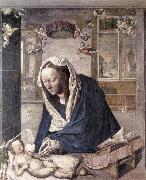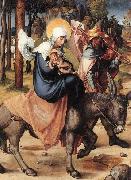
|
Artists
Index
|
||
|
Albrecht Durer
|
||
|
Virgin and Child before an Archway new21/Albrecht Durer-838232.jpg Painting ID:: 63732 |
1495 Oil on panel, 48 x 36 cm Magnani Collection, Mamiano near Parma Mary and the Christ Child sitting in her lap appear to be right in the foreground of a space which opens to one side onto a bordering interior courtyard. The baby reaches for his mother's hand and their eyes meet. While the Madonna still owes much to the Late Gothic German type, the Christ Child is reminiscent of Italian models. Half length figures such as this early picture of the Madonna were widespread in Italy and the Netherlands. The depiction of the space with the view to the side through an arch is reminiscent of Flemish models, but the figural conception and monumental triangular composition of the group of figures also relates to Italy, in particular to the Madonna paintings by Giovanni Bellini. The picture dates either from D?rer's visit to Venice in 1494-5 or soon afterwards in Nuremberg. It was discovered in the 1950s in the Capuchin monastery of Bagnacavallo, near Ravenna, and this suggests that it was painted in Italy where it has remained.Artist:D?RER, Albrecht Title: Virgin and Child before an Archway Painted in 1501-1550 , German - - painting : religious | |
| |
|
|
|
|
||
|
Lot Fleeing with his Daughters from Sodom new21/Albrecht Durer-939533.jpg Painting ID:: 63733 |
1498 Oil and tempera on panel, 52 x 41 cm National Gallery of Art, Washington This delightfully spontaneous panel depicts Lot and his two daughters fleeing from the destruction of Sodom. In the story from Genesis, two angels warn Lot that he should escape before God destroys the city for its sins. Lot is told that his family must not look back, otherwise they will be turned into pillars of salt. In D?rer's panel, Lot leads the way, dressed in a warm fur-lined coat and a magnificent turban. He carries a basket of eggs and has a flask of wine slung over his shoulder on his stick. His two daughters follow several paces behind, one bearing a bundle on her head and the other with an elegant casket and a distaff and yarn. Far behind them, near the towering rocks, is Lot's wife, transformed into a brown pillar of salt. In the distance the town of Sodom explodes with brimstone and fire, huge columns of smoke belching up into the sky. Gomorrah, in the far distance, suffers a similar fate. This depiction of Lot's flight is not the main picture, but the reverse of a panel of the Virgin and Child. The two sides are quite different, not only in subject-matter but also in style. The Lot panel is painted in a loose, spontaneous manner, whereas the Virgin and Child is much more finely worked. However, D?rer must have intended them to be seen together. The panel was painted for the Nuremberg merchant family of Haller, whose arms appear in the bottom left corner of the panel of the Virgin. Virgin and Child at a Window was long assumed to be the work of the Venetian artist Giovanni Bellini, because of its composition and colouring. In 1934 it was identified as a D?rer, painted about three years after his return from Venice. It was bought by Baron Heinrich von Thyssen-Bornemisza, who owned it until 1950.Artist:D?RER, Albrecht Title: Lot Fleeing with his Daughters from Sodom Painted in 1501-1550 , German - - painting : religious | |
| |
|
|
|
|
||
|
The Dresden Altarpiece new21/Albrecht Durer-936722.jpg Painting ID:: 63734 |
1496 Oil on canvas, 117 x 96,5 cm (central panel), 114 x 45 cm (each wing) Gem?ldegalerie, Dresden The altarpiece was commissioned by Frederick the Wise for the church of the Wittenberg Castle. The altarpiece was in the Kunstkammer in Dresden as early as 1687 which explains its name. The central panel depicts Mary adoring the Child, while the side wings represent St Anthony and St Sebastian. The central panel, displayed with the side panels in the Gem?ldegalerie, has also been attributed to D?rer in the past. However, this attribution was rejected in 1991 on solid grounds and it was attributed to a Dutch painter of the name Jan, who worked in Frederick's court.Artist:D?RER, Albrecht Title: The Dresden Altarpiece Painted in 1501-1550 , German - - painting : religious | |
| |
|
|
|
|
||
|
The Dresden Altarpiece new21/Albrecht Durer-923237.jpg Painting ID:: 63735 |
1496 Oil on canvas, 117 x 96,5 cm Gem?ldegalerie, Dresden The attribution of the central panel to D?rer, displayed with the side panels in the Gem?ldegalerie, was rejected in 1991 on solid grounds and it was attributed to a Dutch painter of the name Jan, who worked in Frederick's court.Artist:D?RER, Albrecht Title: The Dresden Altarpiece (central panel) Painted in 1501-1550 , German - - painting : religious | |
| |
|
|
|
|
||
|
The Seven Sorrows of the Virgin: The Flight into Egypt new21/Albrecht Durer-689432.jpg Painting ID:: 63736 |
1496 Oil on pine panel, 63 x 45,5 cm Gem?ldegalerie, Dresden The Flight into Egypt is one of seven scenes from the Life of Christ which originally surrounded the large central panel of the Mother of Sorrows. In the Gospel of St Matthew (Matt. 2, 13-14), the event is mentioned briefly, though narrated in more detail in the Apocrypha. King Herod ordered that all newborn sons should be killed once he had found out that a future king would be born in Judea. An angel conveys to Joseph God's message to leave the town. Thus the Holy Family fled to Egypt. The group of figures, with Mary riding and holding the Christ Child and Joseph leading the ass, is arranged parallel to the picture in the foreground, an arrangement which is repeated in the later woodcut in the Life of the Virgin. In the foreground the path is stony, and in the background a rocky landscape is visible. The rock is a sign of a safe place of refuge, but can also be interpreted as a mariological and christological symbol: "The stone which the builders rejected, the same is become the head of the corner" (Matt. 21, 42). Both the composition and method of painting still owe much to the Late Medieval workshop tradition.Artist:D?RER, Albrecht Title: The Seven Sorrows of the Virgin: The Flight into Egypt Painted in 1501-1550 , German - - painting : religious | |
| |
|
|
|
|
||
| Prev artist Next artist | ||
|
Also Buy::. For Following Paintings / Artists / Products, Please Use Our Search Online: |











